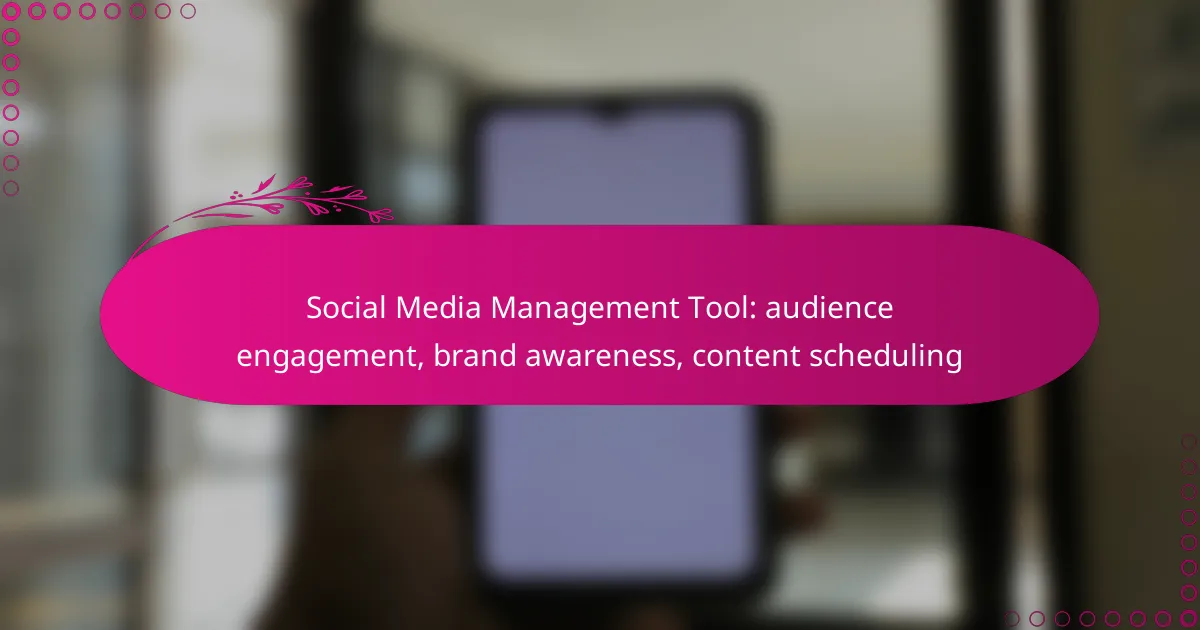Social media management tools play a crucial role in enhancing audience engagement and brand awareness by enabling real-time interactions and targeted content delivery. By utilizing features like content scheduling and analytics, brands can optimize their communication strategies, ensuring they connect effectively with their audience while fostering loyalty and recognition. These tools streamline the process of maintaining a consistent online presence, ultimately driving better results across various platforms.

How can social media management tools boost audience engagement in Canada?
Social media management tools can significantly enhance audience engagement in Canada by facilitating real-time interactions, providing valuable analytics, and enabling targeted content delivery. These tools streamline communication, allowing brands to connect more effectively with their audience and foster a loyal community.
Real-time interaction features
Real-time interaction features allow brands to engage with their audience instantly, responding to comments, messages, and mentions as they occur. This immediacy helps create a sense of connection and community, which is crucial for maintaining audience interest.
Tools like live chat and comment monitoring can enhance engagement by enabling brands to address customer inquiries or feedback promptly. For instance, a Canadian brand might use these features during a product launch to answer questions and encourage participation.
Analytics for audience insights
Analytics tools provide valuable insights into audience behavior, preferences, and engagement patterns. By analyzing metrics such as likes, shares, and comments, brands can better understand what content resonates with their Canadian audience.
Using these insights, brands can refine their strategies, focusing on content types and topics that drive engagement. For example, if analytics show higher interaction rates with video content, a brand might prioritize video production in its social media strategy.
Automated responses
Automated responses can streamline communication by providing immediate answers to common questions. This feature is particularly useful for brands with a large following, as it ensures that audience inquiries are addressed without delay.
For instance, a Canadian retail brand could set up automated replies for frequently asked questions about shipping policies or store hours. This not only saves time but also enhances customer satisfaction by providing quick access to information.
Targeted content delivery
Targeted content delivery allows brands to tailor their messages to specific audience segments, increasing relevance and engagement. By using demographic and behavioral data, brands can create personalized content that speaks directly to the interests of their Canadian audience.
For example, a brand could target promotions based on location, offering special deals to customers in major Canadian cities. This localized approach can significantly boost engagement by making content feel more relevant and timely to the audience.

What are effective strategies for brand awareness using social media tools?
Effective strategies for brand awareness using social media tools include creating a content calendar, promoting across multiple platforms, partnering with influencers, and maintaining consistent branding. These approaches help engage audiences and enhance visibility, ultimately driving brand recognition.
Content calendar integration
Integrating a content calendar into your social media strategy allows for organized and timely posts. This ensures that content is consistently shared, aligning with marketing campaigns and seasonal trends. Aim to plan at least a month in advance to accommodate holidays and events relevant to your audience.
Use tools like Hootsuite or Buffer to schedule posts, which can save time and help maintain a steady flow of content. Regularly review and adjust your calendar based on engagement metrics to optimize future posts.
Cross-platform promotion
Cross-platform promotion involves sharing content across various social media channels to reach a broader audience. This strategy enhances brand visibility by leveraging the unique strengths of each platform, such as Instagram’s visual appeal or Twitter’s real-time engagement.
Consider tailoring your message for each platform while maintaining core branding elements. For instance, use eye-catching images on Instagram and concise, impactful text on Twitter to engage users effectively.
Influencer partnerships
Partnering with influencers can significantly boost brand awareness by tapping into their established audiences. Choose influencers whose values align with your brand and who have a genuine connection to their followers, as authenticity drives engagement.
Start by identifying micro-influencers with niche audiences, as they often yield higher engagement rates. Collaborate on campaigns that resonate with their followers, such as giveaways or product reviews, to maximize impact.
Consistent branding across channels
Maintaining consistent branding across all social media channels is crucial for building brand recognition. This includes using the same logo, color scheme, and tone of voice, which helps create a cohesive identity that audiences can easily recognize.
Regularly audit your profiles to ensure alignment and make adjustments as necessary. Consistency fosters trust and familiarity, encouraging users to engage more with your brand and share it within their networks.

How does content scheduling improve social media performance?
Content scheduling enhances social media performance by allowing brands to post at optimal times, maintain a diverse content mix, and minimize manual efforts. This strategic approach leads to better audience engagement and increased brand visibility.
Optimal posting times
Identifying optimal posting times is crucial for maximizing engagement. Research indicates that posting during peak user activity hours can significantly increase visibility and interaction rates. For example, weekdays around midday often see higher engagement compared to late nights or early mornings.
Utilizing analytics tools can help determine when your specific audience is most active. Regularly reviewing these insights ensures your posting schedule remains effective as audience habits evolve.
Content variety planning
Planning a variety of content types keeps your audience engaged and interested. Mixing formats such as images, videos, polls, and articles caters to different preferences and encourages interaction. For instance, a weekly video series can complement daily posts featuring user-generated content.
Creating a content calendar that outlines diverse themes and formats can help maintain consistency and creativity. This approach not only enhances engagement but also strengthens brand identity.
Reduced manual workload
Scheduling content reduces the need for constant manual posting, freeing up time for other important tasks. Automation tools allow you to prepare and queue posts in advance, ensuring a steady flow of content without daily effort. This is especially beneficial for brands managing multiple platforms.
However, it’s essential to monitor scheduled posts and engage with real-time interactions. Balancing automation with personal engagement helps maintain authenticity and responsiveness.
Enhanced audience reach
Effective content scheduling can significantly expand your audience reach. By posting at times when your target demographics are online, you increase the likelihood of shares and interactions, which can lead to organic growth. This is particularly important for brands aiming to penetrate new markets.
Additionally, leveraging analytics to adjust your scheduling strategy based on audience behavior can further enhance reach. Regularly testing different posting times and formats helps refine your approach and optimize results over time.

What criteria should be considered when choosing a social media management tool?
When selecting a social media management tool, consider factors such as integration capabilities, pricing structures, and user experience. These criteria will help ensure that the tool meets your specific needs for audience engagement, brand awareness, and content scheduling.
Integration with existing platforms
Choosing a social media management tool that integrates seamlessly with your current platforms is crucial. Look for tools that connect with popular social networks like Facebook, Twitter, Instagram, and LinkedIn, as well as with analytics and CRM systems. This integration allows for streamlined workflows and better data analysis.
Check if the tool supports APIs or has built-in connectors for other software you use. For example, if you rely on email marketing services or e-commerce platforms, ensure compatibility to enhance your overall marketing strategy.
Pricing plans and features
Evaluate the pricing plans and features of various social media management tools to find one that fits your budget and requirements. Many tools offer tiered pricing, ranging from basic plans for small businesses to comprehensive packages for larger enterprises. Compare what each plan includes, such as post scheduling, analytics, and customer support.
Consider whether the tool offers a free trial or a money-back guarantee. This allows you to test the features before committing financially, ensuring that the tool aligns with your engagement and scheduling needs.
User interface and experience
The user interface and overall experience of a social media management tool can significantly impact your team’s productivity. A clean, intuitive interface makes it easier to navigate and utilize the tool effectively. Look for features like drag-and-drop scheduling and customizable dashboards that enhance usability.
Gather feedback from team members who will be using the tool. A user-friendly experience can lead to higher adoption rates and better engagement outcomes. Avoid tools that have a steep learning curve, as they can hinder your ability to manage social media effectively.

Which social media management tools are popular in Canada?
In Canada, popular social media management tools include Hootsuite, Buffer, and Sprout Social. These platforms help businesses enhance audience engagement, boost brand awareness, and streamline content scheduling.
Hootsuite
Hootsuite is a leading social media management tool that allows users to manage multiple accounts from one dashboard. It provides features for scheduling posts, monitoring social media activity, and analyzing performance metrics.
Canadian businesses often appreciate Hootsuite’s robust analytics capabilities, which can help track engagement and reach. The platform also offers a free version, making it accessible for smaller businesses or those just starting out.
Buffer
Buffer is known for its user-friendly interface and straightforward scheduling features. It allows users to plan and publish content across various social media platforms efficiently.
Many Canadian marketers favor Buffer for its simplicity and effectiveness in managing posts. The tool also provides analytics to help users understand what content resonates best with their audience, enabling better engagement strategies.
Sprout Social
Sprout Social offers comprehensive social media management with a focus on engagement and collaboration. It includes features for scheduling, monitoring, and reporting, making it suitable for teams.
This tool is particularly beneficial for Canadian companies looking to enhance brand awareness through detailed insights and customer engagement tools. Sprout Social’s robust reporting features help businesses measure their social media impact effectively.
